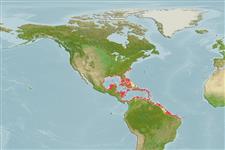>
Gobiiformes (Gobies) >
Eleotridae (Bully sleepers)
Etymology: Dormitator: Latin, dormire = to sleep (Ref. 45335); maculatus: Specific name means 'spotted' or 'stained'..
More on author: Bloch.
Environment: milieu / climate zone / depth range / distribution range
Ökologie
seewasser; süßwasser; brackwasser demersal; amphidrom (Ref. 51243). Tropical; 17°C - 35°C (Ref. 35237); 37°N - 5°S
North to South America: along the Atlantic slope from North Carolina (USA) to southeastern Brazil.
Size / Gewicht / Alter
Maturity: Lm ? range ? - ? cm
Max length : 70.0 cm TL Männchen/unbestimmt; (Ref. 26340); common length : 14.5 cm TL Männchen/unbestimmt; (Ref. 12193)
Rückenflossenstacheln (insgesamt): 1 - 7; Rückenflossenweichstrahlen (insgesamt): 9-15; Afterflossenstacheln 0-1; Afterflossenweichstrahlen: 9 - 10. A short stubby fish with a conspicuously flat head (Ref. 26938).
Facultative air-breathing in the genus (Ref. 126274); Adults inhabit marshes, muddy ponds and channels with a salinity range of 0 to 21 ppt (Ref. 7251), up to 38.4 ppt in some cases (Ref. 97140). Mostly found in fresh water but also in brackish mangrove areas. They ascend upstream but remain in the lower reaches. Sexually mature after one year. Gonads develop during the dry season. Average size at maturity is 5.1 cm for males, 4.5 cm for females. Omnivorous, adults feed mainly on plants, sediments and invertebrates. They undergo coloration change during reproduction, carrying out a complex nuptial parade. Adults guard the nest. Egg is 0.3 mm, incubation time is 11 to 16 hours at 27°C (Ref. 35237).
Life cycle and mating behavior
Geschlechtsreife | Fortpflanzung | Ablaichen | Eier | Fecundity | Larven
Robins, C.R. and G.C. Ray, 1986. A field guide to Atlantic coast fishes of North America. Houghton Mifflin Company, Boston, U.S.A. 354 p. (Ref. 7251)
IUCN Rote Liste Status (Ref. 130435)
Bedrohung für Menschen
Harmless
Nutzung durch Menschen
Aquarium: Kommerziell
Mehr Information
NamenSynonymeMetabolismusRäuberÖkotoxikologieFortpflanzungGeschlechtsreifeAblaichenSpawning aggregationFecundityEierEientwicklung
PartnerBilderStamps, Coins Misc.LauteCiguateraGeschwindigkeitSchwimmstilKiemenoberflächeOtolithsGehirngrößeSehfähigkeit
Tools
Zusatzinformationen
Download XML
Internet Quellen
Estimates based on models
Preferred temperature (Ref.
123201): 23.5 - 28.1, mean 27.3 °C (based on 807 cells).
Phylogenetic diversity index (Ref.
82804): PD
50 = 0.5312 [Uniqueness, from 0.5 = low to 2.0 = high].
Bayesian length-weight: a=0.01023 (0.00391 - 0.02676), b=3.02 (2.79 - 3.25), in cm total length, based on LWR estimates for this (Sub)family-body shape (Ref.
93245).
Trophic level (Ref.
69278): 2.5 ±0.1 se; based on diet studies.
Widerstandsfähigkeit (Ref.
120179): niedrig, Verdopplung der Population dauert 4,5 - 14 Jahre. (Preliminary K or Fecundity.).
Fishing Vulnerability (Ref.
59153): Moderate to high vulnerability (48 of 100).
Nutrients (Ref.
124155): Calcium = 90.6 [51.5, 209.0] mg/100g; Iron = 0.891 [0.443, 1.695] mg/100g; Protein = 18 [16, 20] %; Omega3 = 0.167 [0.096, 0.275] g/100g; Selenium = 44.5 [22.5, 96.4] μg/100g; VitaminA = 14.7 [4.5, 40.1] μg/100g; Zinc = 1.63 [1.14, 2.44] mg/100g (wet weight);
